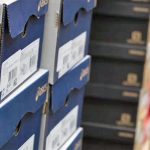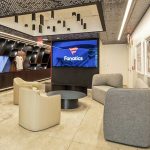Fila Holdings Corp. continued to see the global impact of the footwear inventory glut experienced by most other active lifestyle brands in the second quarter but was able to offset most of the decline with a solid contribution from the Acushnet business. However, the company was not so lucky with margins or profits as inventory liquidation took its toll on the quarter’s profits.
The Korea-based business, home to the Fila brand and parent to the U.S.-based Acushnet Golf business, which includes the Titleist and Footjoy businesses, reported total revenues of ₩1,147.0 billion in Q2, a 2.1 percent decrease year-over-year. Assessing the business without the benefit of the FX Rate benefit was a bit tougher as sales fell 5.7 percent for the quarter in currency-neutral terms versus the year-ago quarter. The company reports in Korean Won currency.
Consolidated gross margins were 46.6 percent of sales in the second quarter, down 160 basis points from the 2022 second quarter. Margins contracted 150 basis points in currency-neutral terms.
Consolidated operating profit fell 39.7 percent in the period to ₩91.94 billion in Korean won terms and fell 41.7 percent in currency-neutral terms. Operating margins were just 8.0 percent of sales in Q2, down 500 basis points from Q2 last year and down 620 basis points from the first quarter.
Consolidated net profit for Fila Holdings was ₩37.20 billion in the second quarter, down 67.5 percent in Korean won terms and down 67.7 percent in currency-neutral terms.
Overall Fila brand revenues were ₩241.0 billion in the quarter, down 29.7 percent year-over-year, or down 31.1 percent in currency-neutral terms. The first quarter trend, while down sharply, reflected a moderating decline versus the first quarter results. The story here was similar to most other footwear and apparel brands in the market, with the company pointing to the U.S. consumer market, excessive inventory and increased promotional activity. Where the impact was really felt for the footwear business was in the gross margin line and resulting operating profit and net profit lines due to increased discounting to reduce inventory.
Fila brand operating profits fell 39.7 percent (-41.7 percent currency-neutral) to ₩91.94 billion in the second quarter.
Fila USA
Fila USA revenues, which covers the U.S., Canada and Mexico, declined 22.3 percent (-24.9 percent currency-neutral) in Q2 to ₩91.53 billion ($69.6 million), due to the decreased revenues and overall gross profit decline. While sharply negative, the sales decline was a clear improvement from the 33.5 percent decline posted in the first quarter for this business.
The company said the U.S. consumer market continued to weaken due to the ongoing issue of excessive inventory, leading to increased promotional activities and conservative orders from retailers. The company saw continued “inventory digestion” through discount channels, which affected margins.
Fila USA’s gross margin was a negative 47.8 percent of sales in the quarter, both in U.S. dollar terms and Korean won terms, down 69.2 full points from Q2 last year. Margins were said to be negatively impacted by increased promotional activity aimed at liquidating inventories, as well as inventory provision recognition of $24 million. Fila USA SG&A expenses were ₩33.30 billion ($25.3 million) in the quarter, down 7.4 percent year-over-year, or down 10.9 percent in U.S. dollar terms.
Fila USA posted an operating loss of ₩77.08 billion (-$58.6 million) in the quarter, a considerable increase from the loss of ₩10.77 billion in the year-ago period, due to the decreased revenues, declining gross profit and fixed expenses.
Fila USA posted a net loss of ₩79.20 billion (-$60.2 million) in Q2 compared to a loss of ₩9.02 billion in Q2 last year.
Fila Korea
Fila Korea, excluding a Design Services Fee (DSF), fell 30.1 percent in Korean won terms to ₩77.24 billion in the quarter. Design Service Fees were up 9.5 percent to ₩17.29 billion in Q2. The company said the decline reflected “continued aggressive channel adjustment such as reducing low margin/de-branding channels for prioritizing the enhancement of the brand.” In other words, they cleaned up distribution to maintain brand value.
Fila Korea’s gross margin improved 340 basis points to 62.5 percent of sales in Q2, but gross profit was down 20.8 percent, due to a decrease in revenue and an increase in product costs resulting from product quality enhancement efforts, partially offset by an increase in average selling prices. SG&A expenses declined 9.0 percent to ₩44.55 billion in Q2.
Fila Korea’s operating profit was down 43.5 percent to ₩14.50 billion in the quarter, mainly driven by a decrease in revenue and despite tight expense controls.
Fila Korea’s net profit fell 40.9 percent year-over-year to ₩11.85 billion in Q2 2023.
Acushnet
The Acushnet company, the parent of the Titleist and FootJoy brands that is 52 percent owned by Fila Holdings, saw revenues increase 9.3 percent (+4.8 percent currency-neutral) in the period to ₩906.01 billion ($689.4 million). Sales increased 4.7 percent in U.S. dollar terms, exceeding Wall Street’s consensus estimate of $675 million in sales. Net income rose 12.3 percent to $74.7 million, or $1.09 a share, surpassing Wall Street’s consensus estimate of 93 cents.
For more on the results from Acushnet, go here to read SGB Media‘s coverage.
Outlook
Looking ahead, Fila Holdings kept its revenue outlook unchanged from its fist quarter forecast, but the view also includes upside from Acushnet offset by lowered expectations for the Fila brand worldwide, particularly in the U.S.
Fila USA’s revenue estimate was moved to a range of negative 50 percent to negative 40 percent from the prior forecast of a range of negative 25 percent to negative 20 percent for the year. The Fila USA business is now expected to show an operating loss of ₩180 billion to ₩160 billion versus the previous forecast of a loss of ₩110 billion to ₩90 billion.
Fila Korea, excluding DSF, saw its forecast decline double, to a range of negative 30 percent to negative 20 percent from he Q1 view of a range of negative 15 percent to negative 10 percent.
The outlook for consolidated operating profit increased to a range of negative 40 percent to negative 30 percent from the Q1 forecast calling for a range of negative 20 percent to negative 10 percent.
Photo courtesy Fila
















